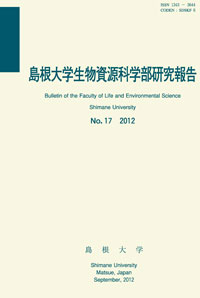島根大学生物資源科学部
ISSN:2435-0885(オンライン)
ISSN:1343-3644(冊子体)
なお、冊子体の刊行は23巻まで
ISSN:1343-3644(冊子体)
なお、冊子体の刊行は23巻まで

ダウンロード数 : ? 件
この文献の参照には次のURLをご利用ください : https://ir.lib.shimane-u.ac.jp/5651
島根大学生物資源科学部研究報告 9
2004-08-31 発行
幼穂の発育に及ぼす温度の影響
Effects of Temperature on the Development of Rice Panicles
ファイル
内容記述(抄録等)
The relationship between temperature and spikelet number per panicle in rice was examined. Two experiments were conducted: Experiment 1)a treatment of air temperature(AT)and Experiment 2)a treatment of water temperature(WT). In experiment1, three regimes of AT were applied: High temperature,32/24℃(day/night); Medium temperature,29/21℃; Low temperature,26/18℃. In Experiment 2, three levels of WT(26,29,32℃)were applied in day. WT at night was not controlled independently from the AT. Dry weights were measured at the stage of spikelet differentiation. At heading, dry weights and the number of differentiated spikelets and primary and secondary rachis-branches per panicle were measured. High AT during the early reproductive stage reduced the number of differentiated spikelets. High AT did not decrease dry matter accumulation, but changed the allocation of dry matter among organs. High AT promoted dry matter accumulation to leaves, but decreased dry matter accumulation to tillers. Low WT increased the number of differentiated spikelets, but decreased the number of surviving spikelets through increasing of spikelet degeneration. The WT treatment little affected dry matter accumulation and partitioning among organs. 13C atom percents in leaf blades and leaf sheaths at heading were higher than those in panicles, which result suggested that carbohydrates assimilated at the stage of spikelet differentiation were translocated into actively growing organs such as leaves prior to young panicles. The role of temperature in spikelet differentiation was discussed.
About This Article
Other Article
